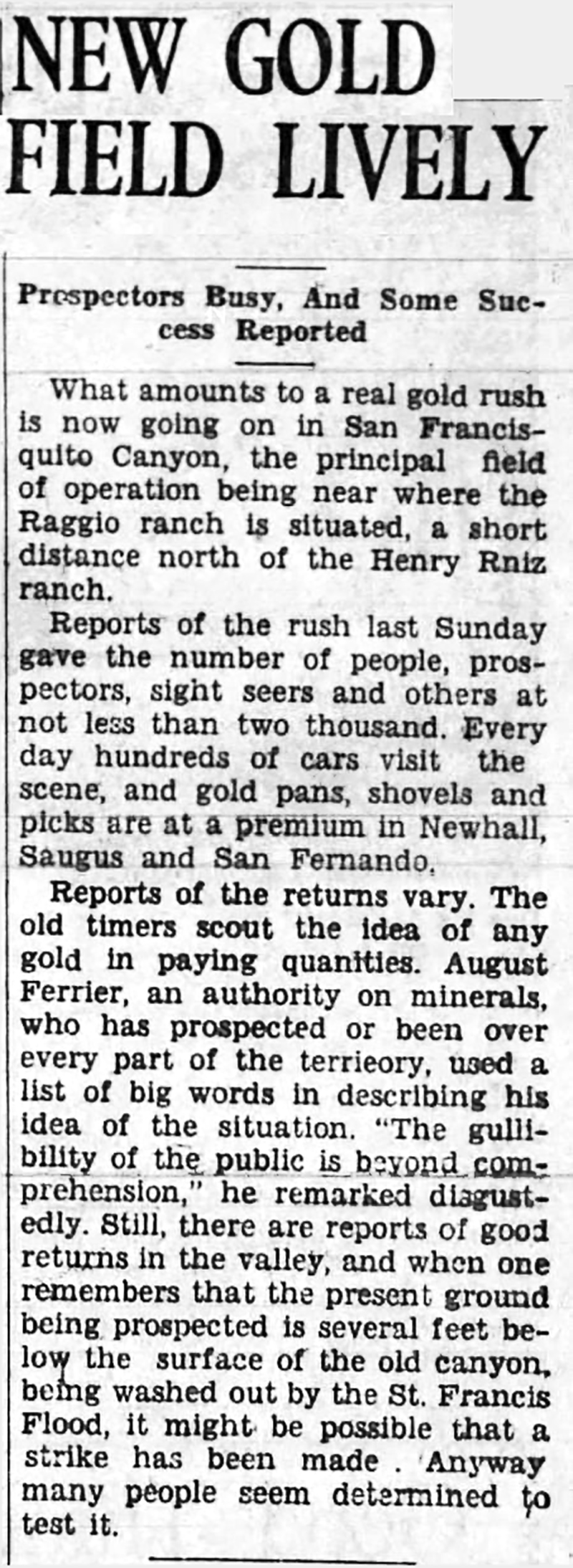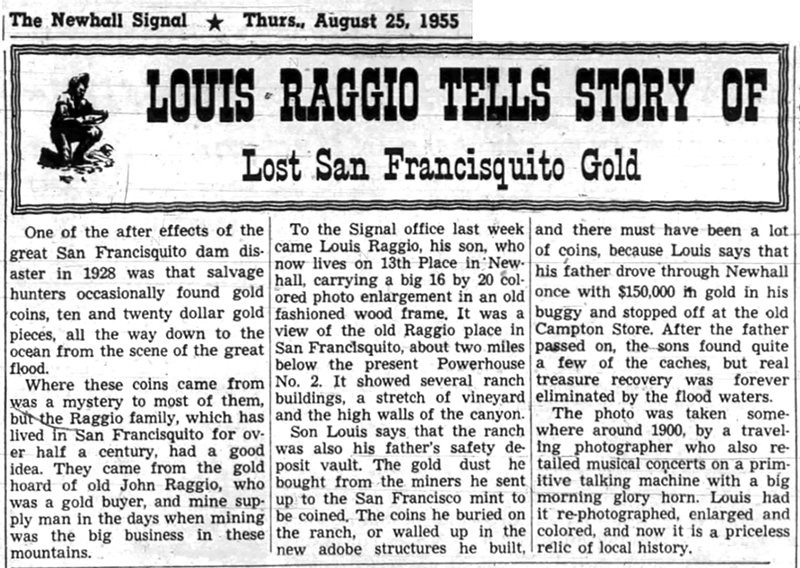|
|

|
Webmaster's note.
The webmaster is personally acquainted with an individual who found a $5 gold piece in the mid-2010s on private land downstream from the Raggio property. The individual had authority to be on the land where the coin was found and sold it. Scroll down to see how it would have gotten there.
The Dragon's Teeth. Eighty Acres Sown in Gold. Forty Thousand Dollars Like Wheat in a Field. Saugus Pioneer a Cadmus of Modern Thebes. Heirs Scratch Frantically for Buried Wealth. Los Angeles Times | November 7, 1912. A strange story of a search for buried treasure with divining rods, spirit mediums, lodestones and good picks and shovels came to light yesterday, when Stephen Abonisia, 19 years old, was fined $100 by Justice Reeve for running a blind pig at the "Old Winery Place," nine miles north of Saugus. [Webmaster's note: A blind pig is an illegal drinking establishment. The term predates Prohibition.] The treasure amounts to $40,000 and was buried piecemeal beneath the soil of the eighty-acre vineyard by Charles Raggio, a Los Angeles pioneer, according to Frank Raggio, his son. The younger man came to court to arrange for the payment of Abonisia's fine, this because the aged Mexican is still in his employ. Charles Raggio accumulated his money by trade with placer miners, who prospected the country about Saugus forty years ago, followed by a train of frugal Chinese, who used to buy their necessaries at his store. Much of Raggio's receipts were in gold-dust. Some was in nuggets, and a little in bank-notes. He had a deep-seated distrust of all banks and burled his money as it accumulated, in places known only to himself. "I shall spread it around," he told his wife, according to the son. "Even if anyone gets part of it he cannot get it all. But I shall not tell anybody where it is: people sometimes talk when they shouldn't. You will know before I die, and it will go to yon and the children." Twenty-seven years ago Raggio died suddenly of a hemorrhage at Newhall, where he had gone to buy goods. With him perished knowledge of his hoarding places. A little money was found and Mrs. Raggio discovered some of her jewels in an adobe wall of the winery, high up among the rafters. No will was left. The widow was even obliged to send to Washington for a copy of Raggio's patent to the land he had taken up. The family began at once to dig, and has been turning up the soil ever since. Once $815 was found when a post-hole was sunk. Liter Mrs. Raggio picked up a $20 gold piece in a pile of sand in the cellar. Digging commenced, and the sand was put through a sieve. The operation brought $200 to light. "All sorts of spiritualists and diviners have come there and worked," he went on. "One had a magic rod, that was to dip downward when over the treasure. It didn't dip. Another was of metal, that was to become discolored when near the precious hoard. It remained bright and untarnished. A medium went to sleep and expected to awaken in the night, with a big hunch about where all that money was. He woke up all right, but only said he was hungry. We went back then to the picks and shovels. No luck. "A few years after my father died we rented the ranch to people who found letters of his and the missing patent when a piece of adobe fell out of a wall. We thought they might have come upon a map, to show where the monev was planted. They denied that, and I don't think they had it. We're still hunting. The thought of so much money being there makes me lie awake nights." Raggio lives at No. 2536 Wabash street, Los Angeles. He said "he had no knowledge of Abonisia's sale of liquor in his absence from the ranch. Because of the defendant's age and his inability either to endure imprisonment or pay a fine, sentence was remitted.
Divide Fortune Found on Farm.
Death of Horseman Traveling Incognito Reveals Gold's Hiding Place.
Oakland Tribune | January 18, 1914.
LOS ANGELES, Jan. 17. — The shower of gold which began to descend upon Frank, Joe and Louis Raggio and their sisters several months ago, when they plowed up the Raggio ranch, in the San Francisquito canyon, in search of gold burled by their father, is to end in the distribution of $165,000. A statement to this effect was made by Detective Sam Browne upon the receipt of a telegram from St. Louis saying that the estate of John Raggio, an uncle, has been probated. The story of the gold shower is most romantic. Louis Raggio lives at 1630 Bridge street, Boyle Heights. Other members of the family live in different parts of Southern California. The story told by Browne follows: "About two years ago an eastern horseman known as John Rogers was stricken fatally ill. Just before he died he told Arthur Stahl of St. Louis, a former United states secret service man, whom he knew, that he had relatives in California and that his true name was Raggio. "The investigation in California resulted in the Raggios being found in San Francisquito canyon. Their father, Joseph, had died without revealing the hiding place of his wealth and the ranch was plowed. Several cans of gold pieces were unearthed. Then the family engaged investigators in St. Louis and in Turin, Italy, from which places the family originally came. "It was discovered that the horseman, 'Rogers,' or Raggio, as his true name was, had diamonds, racehorses and many valuable pieces of property."
News story courtesy of Lauren Parker.
New Gold Field Lively.
Prospectors Busy, And Some Success Reported.
The Newhall Signal and Saugus Enterprise | Thursday, March 12, 1931.
What amounts to a real gold rush is now going on in San Francisquito Canyon, the principal field of operation being near where the Raggio ranch is situated, a short distance north of the Henry Ruiz ranch. Reports of the rush last Sunday gave the number of people, prospectors, sight seers and others at not less than two thousand. Every day hundreds of cars visit the scene, and gold pans, shovels and picks are at a premium in Newhall, Saugus and San Fernando, Reports of the returns vary. The old timers scout the idea of any gold in paying quantities. August Ferrier, an authority on minerals, who has prospected or been over every part of the territory, used a list of big words in describing his idea of the situation. "The gullibility of the public is beyond comprehension," he remarked disgustedly. Still, there are reports of good returns in the valley, and when one remembers that the present ground being prospected is several feet below the surface of the old canyon, being washed out by the St. Francis Flood, it might be possible that a strike has been made. Anyway many people seem determined to test it.
News story courtesy of Stan Walker.
Louis Raggio Tells Story of Lost San Francisquito Gold. The Newhall Signal | Thursday, August 25, 1955. One of the after effects of the great San Francisquito dam disaster in 1928 was that salvage hunters occasionally found gold coins, ten and twenty dollar gold pieces, all the way down to the ocean from the scene of the great flood. Where these coins came from was a mystery to most of them, but the Raggio family, which has lived in San Francisquito for over half a century, had a good idea. They came from the gold hoard of old John Raggio, who was a gold buyer and mine supply man in the days when mining was the big business in these mountains. To the Signal office last week came Louis Raggio, his son, who now lives on 13th Place in Newhall, carrying a big, 16-by-20 colored photo enlargement in an old-fashioned wood frame. It was a view of the old Raggio place in San Francisquito, about two miles below the present Powerhouse No. 2. It showed several ranch buildings, a stretch of vineyard and the high walls of the canyon. Son Louis says that the ranch was also his father's safety deposit vault. The gold dust he bought from the miners he sent up to the San Francisco mint to be coined. The coins he buried on the ranch, or walled up in the new adobe structures he built, and there must have been a lot of coins, because Louis says that his father drove through Newhall once with $150,000 of gold in his buggy and stopped off at the old Campton Store. After the father passed on, the sons found quite a few of the caches, but real treasure recovery was forever eliminated by the flood waters. The photo was taken somewhere around 1900. by a traveling photographer who also retailed musical concerts on a primitive talking machine with a big morning glory horn. Louis had it re-photographed, enlarged and colored, and now it is a priceless relic of local history.
|
LeBrun 1890s
New Gold Discoveries 6-6-1897
Seek National Park Status 1910
Lost Raggio Gold 1912ff.
Gold Bowl x2
|
The site owner makes no assertions as to ownership of any original copyrights to digitized images. However, these images are intended for Personal or Research use only. Any other kind of use, including but not limited to commercial or scholarly publication in any medium or format, public exhibition, or use online or in a web site, may be subject to additional restrictions including but not limited to the copyrights held by parties other than the site owner. USERS ARE SOLELY RESPONSIBLE for determining the existence of such rights and for obtaining any permissions and/or paying associated fees necessary for the proposed use.








